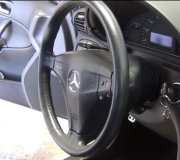Steering pull
This is a condition where the vehicle continually pulls or drifts to one side while traveling straight. The driver typically has to maintain steady pressure on the steering wheel to keep the vehicle on the road. Possible causes include:
Uneven camber side-to-side. Too much cross-camber can make a vehicle pull or lead towards the side that has the most (positive) camber or away from the side that has the least (negative) camber. The underlying cause may be a bent strut or mislocated strut tower, a bent spindle, collapsed control arm bushing, weak or broken spring, or a shifted crossmember or engine cradle. Check SAI and the included angle to see if these are in or out of specs to diagnose the problem. Also check ride height. Correct by replacing worn or damaged parts, correcting location of strut tower, repositioning engine cradle, and/or reducing cross-camber to half a degree or less by readjusting camber to specifications.
Uneven caster side-to-side. Too much cross-caster can make a vehicle pull or lead towards the side that has the least (negative) caster. The underlying cause may be a bent strut, spindle or mislocated strut tower. Correct by replacing damaged part, correcting location of strut tower, and/or reducing cross-caster to half a degree or less by resetting caster to specifications.
Rear axle steer. The front wheels are with alignment specifications but the vehicle pulls to one side. The underlying cause may be rear toe out of specifications, a bent rear axle, chassis misalignment or a stackup of assembly tolerances in the chassis causing rear axle misalignment. Measure and compare the wheelbase on both sides, check for the presence of a thrust angle, and/or measure individual rear toe. Correct by realigning the rear axle or rear toe, or by performing a thrust angle alignment.
Brake drag. The pull is constant to one side and may get worse with the application of the brakes. Raise the vehicle and spin each wheel by hand to check for excessive drag. Possible causes include caliper sticking, frozen or sticking piston in caliper, overfilled fluid reservoir in master cylinder (does not allow caliper pistons to retract when brakes are released), weak drum brake return springs, misadjusted drum brakes, misadjusted parking brake, misadjusted parking brake pedal switch (creates residual pressure in the master cylinder to cause drag). Readjust or repair brakes as required.
NOTE: If the pull only occurs when the brakes are applied, the problem may be unequal braking not a dragging caliper or misalignment. The vehicle will pull towards the side with the stronger front brake and away from the side with the weaker or inoperative front brake. Uneven braking can be caused by a sticking floating caliper, a frozen caliper piston, the use of different grades or brands of brake linings side-to-side, fluid leaks, or contaminated linings on one side (by brake fluid or grease). Correct by repairing brakes as required. Other causes may include worn or loose control arm bushings or strut rod bushings that allow alignment changes when braking, so be sure to inspect these components before blaming the brakes
Monday, February 23rd, 2009 AT 10:00 PM


